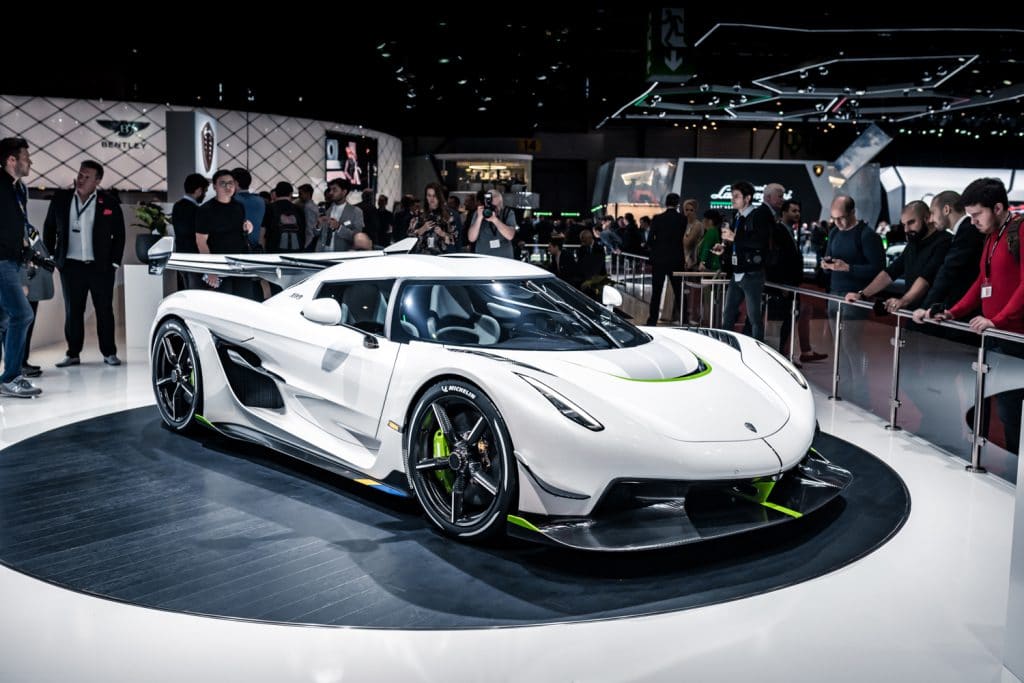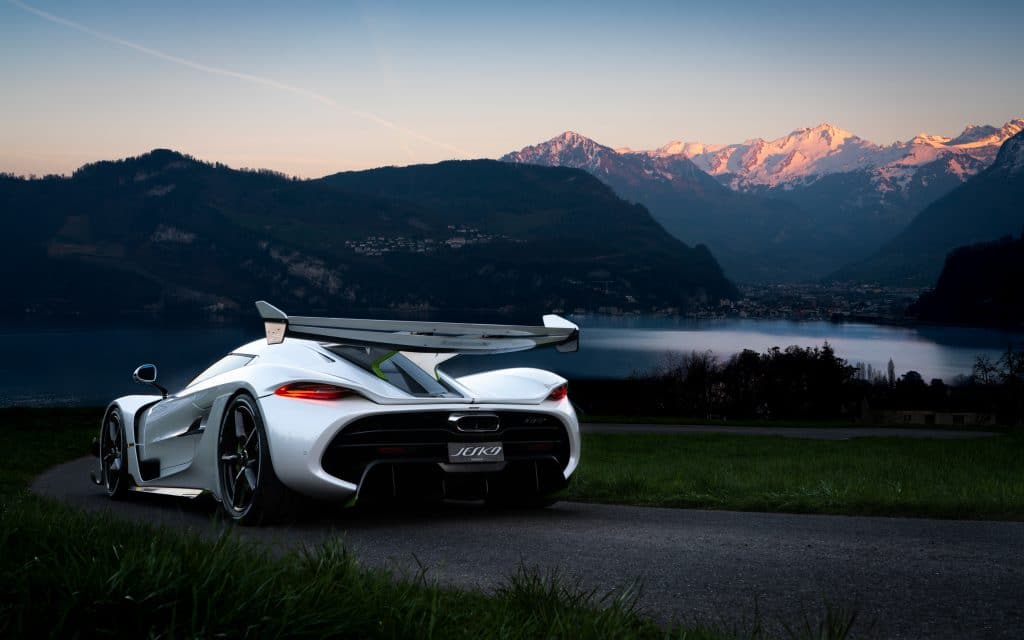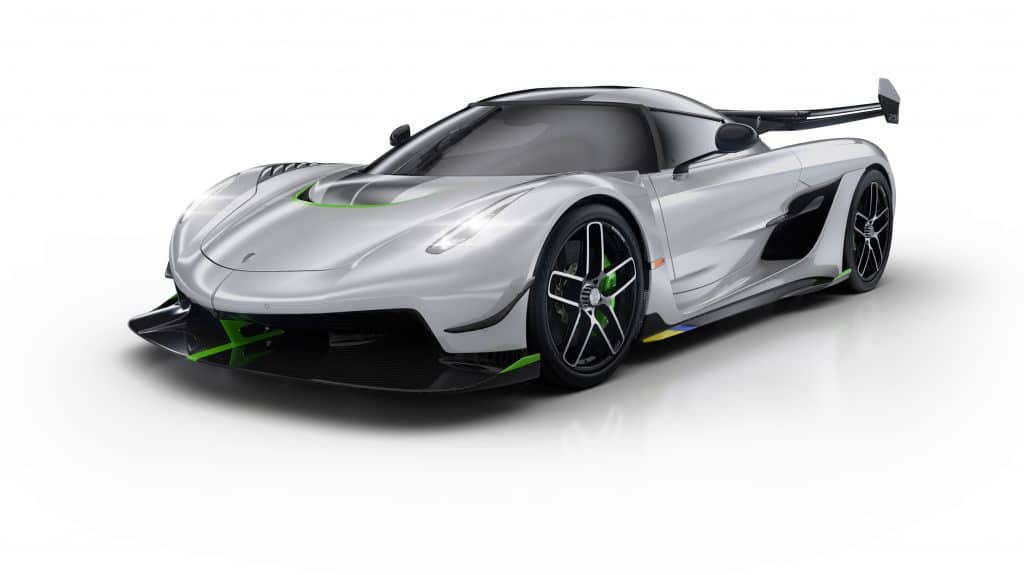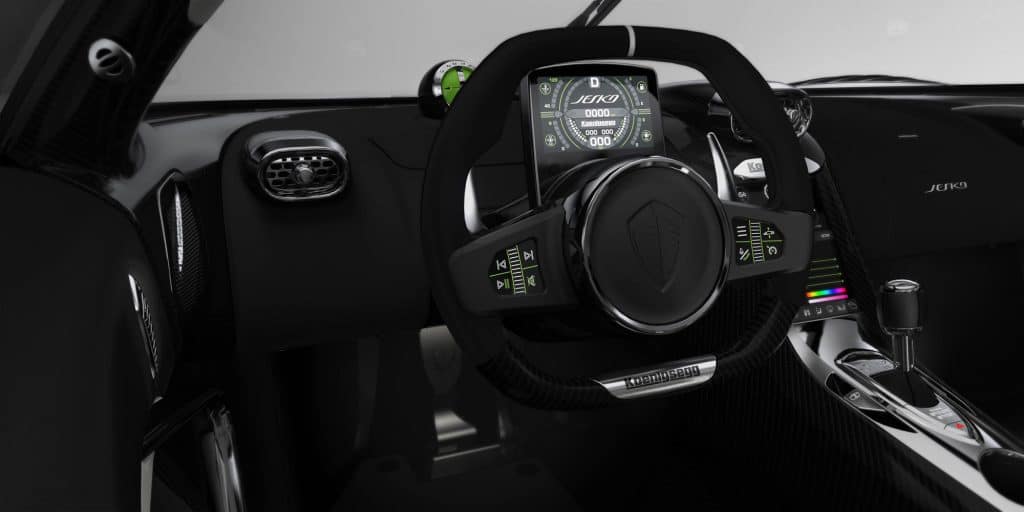Koenigsegg ha presentado un nuevo megacoche, el Koenigsegg Jesko, en el Salón Internacional del Automóvil de Ginebra de 2019. Jesko hereda el manto dejado por el Agera RS como el automóvil líder en carretera y legal para aquellos que buscan lo último en rendimiento de vehículos.
- Rediseñado motor V8 biturbo de 5.0 litros que produce 1280 hp en gasolina estándar y 1600 hp en biocombustible E85
- Nueva y revolucionaria transmisión de velocidad ligera Koenigsegg de 9 velocidades (LST)
- Aerodinámica avanzada que ofrece más de 1000 kg de carga aerodinámica
- Dirección activa de la rueda trasera
- Chasis de fibra de carbono rediseñado con más espacio para las piernas, espacio para la cabeza y mayor visibilidad.
Jesko lleva el nombre de Jesko von Koenigsegg, el padre de la compañía Fundador y CEO, Christian von Koenigsegg.

Koenigsegg Jesko
El primer esfuerzo de Koenigsegg en el desarrollo del motor fue tan exitoso que vio que la compañía recibió un récord mundial Guinness. El Koenigsegg CC8S reemplazó al McLaren F1 como el automóvil con el motor de producción más potente del mundo.

El siguiente motor Koenigsegg logró una hazaña similar cuando el CCR tomó el récord mundial de velocidad máxima del automóvil de producción, nuevamente del McLaren F1. En 2014, anunciamos el Koenigsegg One: 1 con un V8 biturbo que producía 1.360 hp, suficiente para convertir al One: 1 en el primer automóvil de producción de la historia con una relación potencia / peso de 1: 1. Con 1 megavatio de potencia, el One: 1 fue el primer Megacar del mundo.

Esa tradición récord continúa ……
Jesko, el nuevo megacoche de Koenigsegg, está propulsado por un motor V8 de doble turbocompresor y 1280 hp (1600 hp en E85) de nuevo diseño que se beneficia de cambios significativos en el motor Agera al que reemplaza.
En el núcleo del motor de nuevo diseño se encuentra el cigüeñal V8 más ligero del mundo. Con un peso de tan solo 12.5 kilos, el nuevo cigüeñal plano de 180 grados de Koenigsegg le permite a Jesko producir más energía, con mayor eficiencia, mientras alcanza un límite de revoluciones de 8500 rpm.

El cigüeñal es fresado por una pequeña fábrica ubicada en el sur de Suecia. Está hecho con el diseño interno de Koenigsegg a partir de un único tocho de acero sólido.
El diseño plano permite incluso disparar a través de bancos de motores y un sonido de motor aún más visceral. Koenigsegg ha contrarrestado la tendencia que tienen los motores de avión plano hacia una mayor vibración mediante el diseño de nuevas bielas y pistones superligeros.

Las bielas fueron diseñadas por el arquitecto de motores de Koenigsegg, el Dr. Thomas Johansson. Las bielas están hechas de acero sueco de primera calidad. Con solo 540 g, incluidos los tornillos, son tan livianos como las generaciones anteriores hechas de titanio, pero incluso más fuertes.

La cara curva del pistón da forma a la cámara de combustión de tal manera que reduce la presión máxima mientras mantiene una presión media alta. El revestimiento cerámico en la cara del pistón evita los puntos calientes y la detonación cuando el motor funciona a la máxima potencia. El pistón pesa solo 290 gramos. El peso mínimo es importante porque los motores Koenigsegg tienen una carrera muy larga y a 8500 rpm, la eficiencia del movimiento se vuelve crítica.
Transmisión de velocidad de luz (LST)
El Koenigsegg Jesko presenta una nueva transmisión de embrague múltiple de 9 velocidades, la segunda transmisión diseñada y construida 100% internamente en Koenigsegg, siguiendo el sistema Direct Drive diseñado para el Regera.
La transmisión de velocidad de luz Koenigsegg (LST) representa una escala de evolución no vista desde el desarrollo de la tecnología moderna de doble embrague a principios de siglo.
El LST consta de nueve engranajes delanteros y varios embragues multidisco húmedos en un paquete compacto y ultraligero. El LST es capaz de cambios de marcha hacia arriba y hacia abajo entre velocidades a una velocidad cercana a la de la luz gracias a la apertura y cierre simultáneos de embragues que permiten una aceleración / desaceleración totalmente fluida.
Es impresionante que los cambios de marchas LST puedan ocurrir en un tiempo prácticamente cero entre marchas adyacentes.
Sin embargo, lo que lleva a LST de impresionante a evolutivo es que estos beneficios de tiempo de cambio se aplican cuando se cambia entre CUALQUIER engranaje de avance.
UPOD – ULTIMATE POWER ON DEMAND
La clave de esta funcionalidad se encuentra tanto en el diseño único de la transmisión como en la tecnología inteligente ‘UPOD’ de Koenigsegg: Ultimate Power On Demand. UPOD es el cerebro que selecciona y activa instantáneamente un engranaje óptimo para una aceleración máxima.
Si bien las transmisiones modernas de doble embrague (DCT) disfrutan de tiempos de cambio de milisegundos, solo pueden preseleccionar para un cambio rápido en una dirección. Los DCT están diseñados para predecir y preseleccionar la próxima marcha en función de las entradas del controlador. Si esa predicción es incorrecta, por ejemplo, el conductor quiere pasar de la 5ta marcha a la 4ta, en lugar de la 6ta marcha presunta y preseleccionada, el conductor experimentará pérdidas de fuerza G y una respuesta de cambio lenta.
Además, los DCT solo funcionan en intervalos de una sola marcha. De 7ª marcha a 6ª, a 5ª, a 4ª, por ejemplo. Si el conductor está en la 7ª marcha y quiere la 4ª potencia máxima, el DCT no puede preseleccionar la 4ª marcha directamente. El conductor tiene que pasar por la 6ta y 5ta marcha, perdiendo tiempo y potencia.
El Koenigsegg LST supera esto a través de su diseño único de embrague múltiple y la tecnología UPOD, que selecciona la marcha óptima para la máxima potencia con un cambio de velocidad de la velocidad de la luz, independientemente de si esa marcha está a 1, 2 o incluso 5 marchas de distancia.
UPOD usa la velocidad del vehículo y la velocidad del motor para determinar la marcha correcta para obtener la máxima potencia y dirige al LST a activar esa marcha, sin importar su relación con la marcha actual. Si está en la 7ª marcha y la 4ª es la marcha óptima para una aceleración máxima, UPOD puede evitar los cambios descendentes a la 6ª y 5ª marcha y colocar el automóvil directamente de la 7ª a la 4ª velocidad de la luz.
El efecto es instantáneo, una potencia prolífica que siempre está optimizada y siempre disponible, lo que permite una aceleración máxima para adelantamientos, salidas de esquina, etc.
Koenigsegg tiene una larga historia de desarrollo de soluciones innovadoras y internas destinadas a optimizar el rendimiento del vehículo. Lo suficientemente cercano nunca es lo suficientemente bueno. Esta filosofía sin compromisos inspiró el desarrollo de ruedas Aircore de fibra de carbono, Koenigsegg Direct Drive, geometría de suspensión Triplex, el convertidor catalítico RocketCat, tecnología Autoskin y mucho más. LST es lo último en una larga línea de innovaciones de Koenigsegg.

Interior y equipamiento
El nuevo Koenigsegg Jesko está diseñado sin disculpas para ser el automóvil orientado a la pista más capaz jamás hecho para la carretera. Está diseñado para una velocidad prodigiosa, tanto en línea recta como lateral, con control total del conductor.
Sin embargo, eso no significa que uno deba sentirse incómodo.
Jesko está equipado con un conjunto completo de comodidades y un nivel de conveniencia más apropiado para un gran turismo que su arma de pista típica.
La simple pulsación de un botón en el elegante control remoto Koenigsegg opera Autoskin, el sistema pionero de apertura del cuerpo que se muestra por primera vez en el Regera. Los sistemas hidráulicos en miniatura diseñados inicialmente para operar sistemas aerodinámicos ahora se activan para abrir las puertas y capotas del automóvil, lo que permite una verdadera entrada sin contacto.

También se ha rediseñado la bisagra de puerta sincronizada de la hélice sincronizada de Koenigsegg. Ahora se abre ligeramente hacia afuera y hacia arriba en comparación con el original. Esto proporciona aún más espacio para entrar y salir, y reduce el peligro de raspar las aceras altas. El sistema Autoskin incluye sensores para proteger ambas puertas automáticas de la apertura donde se detecta una obstrucción.
El interior está cubierto con materiales de lujo: cuero, alcantara, fibra de carbono, aluminio y vidrio.
Los asientos eléctricos de Jesko se pueden terminar en la elección del cliente de cuero o alcantara, con una variedad casi infinita de opciones de color y contraste. Los asientos deportivos deportivos están construidos alrededor de una carcasa de fibra de carbono, lo que da como resultado un asiento extremadamente ligero y cómodo. Los controles para la posición del asiento y la calefacción están disponibles a través de la pantalla táctil SmartCenter. Los conductores pueden encontrar la posición de conducción perfecta haciendo coincidir su posición de asiento con la columna de dirección y la caja de pedales totalmente ajustables.
RUEDA INTELIGENTE AGREGADA A LA ARQUITECTURA INTELIGENTE DE KOENIGSEGG
Koenigsegg ha desarrollado nuevos controles de controlador utilizando la tecnología de pantalla táctil integrada en el nuevo SmartCenter y SmartWheel.
SmartWheel ve dos pequeñas pantallas táctiles incrustadas en el volante de Jesko, lo que hace que se pueda acceder a un conjunto de funciones con solo un toque o un deslizamiento. Las configuraciones predeterminadas de las pantallas permiten funciones como control de audio, control del teléfono, control de altura de manejo y control de crucero. Sin embargo, las pantallas son sensibles al contexto y otras opciones pueden mostrarse o configurarse en el sistema. Las pantallas de SmartWheel cuentan con retroalimentación háptica, lo que permite un uso sencillo sin la necesidad de una conexión visual constante.
Jesko presenta una nueva pantalla de instrumentos SmartCluster inspirada en las carreras y muy compacta. La pantalla está montada directamente detrás del volante y gira a medida que gira el volante. El nuevo SmartCluster de 5 pulgadas es extremadamente compacto, mide solo 108 mm x 64.8 mm, pero contiene toda la información que necesita el controlador en un diseño ordenado y lógico.
Koenigsegg Jesko red edition




En ese sentido podemos comenzar por apreciar la parte delantera del coche, en donde nos presenta un rostro, por así decirlo, realmente desafiante e intimidante para cualquier adversario. Otro detalle digno de prestar atención es que esta versión estrena un nuevo acabado denominado “LuxuryAndExpensive” que en este caso se trata de acabados compuestos por materiales de primera calidad, lujosos, lo que le agrega un extra de confort y aumenta su costo frente a cualquiera. Entre los elementos más importantes destacan partes y piezas hechos con fibra de carbono, y estos contrastan perfectamente con ese color rojo especial con el que cuenta toda su carrocería.





























